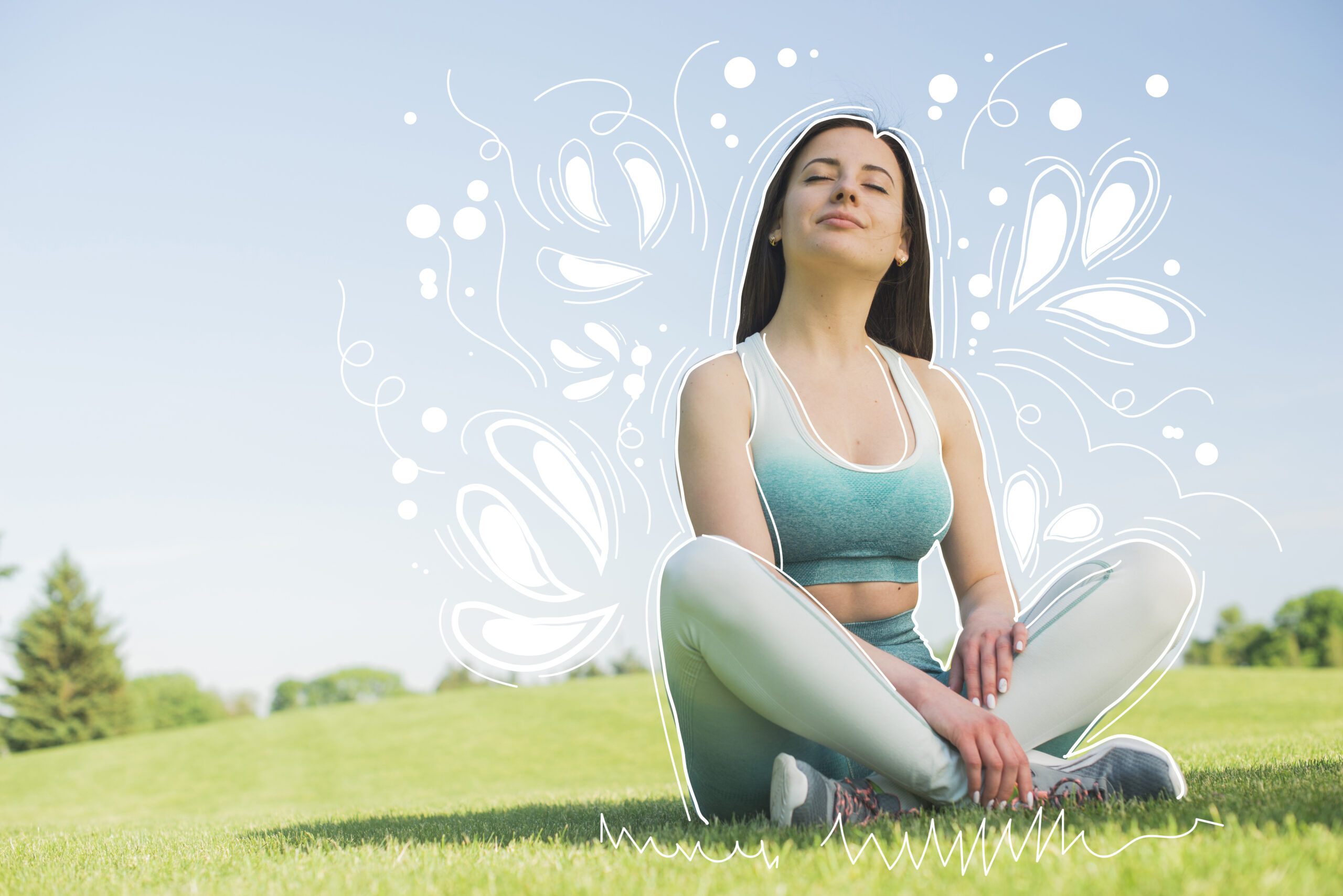Image on Mindfulness Exercises by Freepik
In the fast-paced and demanding world we live in, finding moments of tranquility and inner peace can feel like a rare luxury. However, there is a practice that holds the potential to transform our daily lives and bring a sense of calm amidst the chaos. This practice is mindfulness. Mindfulness is the art of being fully present in the present moment with an open and non-judgmental awareness. It invites us to engage with life in a more conscious and intentional way, cultivating a deep connection to ourselves and the world around us.
Mindfulness, against the common notion, isn’t challenging. It is like training the mind to be more present. Here are some easy mindfulness exercises you can try today.
1. Mindfulness of Being with Self
When was the last time you were utterly, wholly with yourself? Without an agenda or any intent of doing any activity? If you haven’t tried this in a while, schedule 15 minutes from your routine to yourself, doing nothing.
While it may seem counterintuitive, taking time to do nothing can be highly beneficial for the brain and overall well-being. Studies have shown that moments of idleness allow the brain to enter a state of restful wakefulness, which is crucial for creativity, problem-solving, and cognitive functioning. Research shows that individuals who take regular breaks and engage in relaxing activities, like simply staring out of a window, perform better on subsequent tasks compared to those who don’t take breaks.

The connotation of ‘doing nothing’ can be confusing. The idea behind setting a time window that opens possibilities and scope of doing almost anything or nothing is a huge breather. My favorite time of the day is the morning hour, all by myself. At times, I simply enjoy sipping a glass of warm water, or many times just writing random thoughts or dreams to goals of my life or things I am grateful for. Being with yourself can have numerous meanings, but the idea is to keep space to live those minutes without a predefined outcome.
However, it can be a challenging mindfulness exercise. Our minds are often preoccupied with thoughts, worries, and distractions, making it difficult to embrace being with self truly. When we allow ourselves to simply be, without the pressure of accomplishing a to-do list, we create space for self-reflection and rejuvenation.
2. Mindful Eating
Do you often have your dinner with your favorite TV series or movie? Or are you engrossed in the planning of the next meeting while eating? For most of us, eating has become an automated routine, mechanically putting down the food within us. In today’s fast-paced world, many of us have adopted common errors when it comes to eating, such as eating quickly, multitasking while eating, and consuming food mindlessly. These habits can lead to overeating, poor digestion, and a disconnection from our body’s natural hunger and fullness cues.
On the other hand, mindful eating helps you bring your focus back to the food, relishing the taste and absorbing the nourishment it has to offer. Mindful eating is a practice that involves paying full attention to the act of eating and bringing awareness to the sensations, thoughts, and emotions while doing so.

Here are some tips for mindful eating:
- Turn off the TV, and keep aside your handy electronic devices, including phones, iPads, laptops, etc.
- Be grateful for the food you will have.
- Observe and feel your food with all your senses, including its flavor, color, texture, aroma, and taste to savor every bit of your food.
- Eat slowly, in small bites and avoid talking to others while eating.
- Notice any physical sensations, thoughts, or emotions that arise before and while eating.
- Be mindful of how the body absorbs food. When you are aware, you can stop when you are almost full.
- Be curious and non-judgmental about your eating experience. Observe any habits or patterns that emerge without criticizing yourself.
The benefits of mindful eating extend beyond physical health; it can also positively impact our mental and emotional well-being. Research has shown that mindful eating can help reduce stress levels, improve digestion, promote healthier food choices, reduce binge eating, and support weight loss.
3. Mindful Walking
If you find it challenging to practice meditation or do mindfulness exercises, mindful walking is just designed for you. Mindful walking is a form of meditation in motion that involves bringing full attention and awareness to the act of walking. Rather than walking on autopilot, mindful walking invites you to engage your senses and focus your attention on the experience of walking itself.

Here is how you can practice it:
- Start with a centering exercise: Before you begin walking, take a few moments to stand still and bring your awareness to your breath. Allow your body and mind to settle, grounding yourself in the present moment.
- Your intention matters: Clarify your intention for the practice. It could be to cultivate mindfulness, reduce stress, or simply enjoy the experience of walking. Remind yourself to stay present and bring curiosity and non-judgment to the sensations that arise.
- Begin walking mindfully: Start walking at a natural pace, paying attention to the physical sensations involved. Focus on the feeling of your feet making contact with the ground, the movement of your legs, and the shifting of your body weight. You can also pay attention to the sounds, smells, and sights around you, fully immersing yourself in the present moment.
- Gently nudge yourself: As you walk, be aware of any thoughts, emotions, or distractions that arise. Notice them without judgment, and gently bring your attention back to the physical sensations of walking whenever your mind wanders. Engage your senses fully, taking in the details of your surroundings.
- Maintain a steady rhythm: Find a pace that feels comfortable for you and try to maintain a steady rhythm. Allow your breath to flow naturally and synchronize it with your steps if it feels natural to you.
- Reflect on the experience: After your mindful walking practice, take a few moments to reflect on the experience. Notice any changes in your physical and mental state. Observe how you feel in your body, mind, and emotions. Acknowledge any benefits or insights that arise from the practice.
4. Mindful Breathing Exercise
Your breath has the power to control your emotions and mental well-being. Breathing practices are one of the most widely used practices for meditation and mindfulness exercises. When we master the art of conscious breathing, we become the masters of managing our emotional and mental well-being. Simple consciousness of breathing in and out can regulate blood pressure, reduce stress and anxiety, and improve brain activity, metabolism, and sleep patterns.

Follow these simple steps to practice this mindfulness exercise:
- Find a comfortable place to sit. Do not worry about a specific sitting posture or place for mindful breathing. Sit with a naturally straight back, neither hunched nor arched. Do not hesitate to use a pillow to support your back. You can consider sitting next to the wall or even practicing this mindfulness exercise while standing.
- Focus on your breathing: Now, let’s focus to your breath. Take a moment to inhale deeply and exhale slowly. As you do so, let go of any thoughts that may be occupying your mind and direct your attention towards your breath. If you are a beginner, you might find it beneficial to try a simple technique like counting. As you breathe in, count to four silently, then hold for a moment, and finally count to four again as you breathe out. This counting pattern can help you establish a steady and focused breathing rhythm.
- Use the breath as an anchor: Whenever your mind wanders, which is natural, use the breath as an anchor to bring yourself back to the present moment. Each time you notice your mind wandering, gently and non-judgmentally guide your focus back to the breath.
5. Mindful Observation of Nature
We are hard-wired to nature. In fact, the five elements, including water, earth, air, sky, and fire are vital for our health. Immersing ourselves in natural environments allows us to recharge, restore our energy levels, and find solace in the serenity and beauty that surrounds us. Whether it’s the soothing sound of waves crashing on the shore, the vibrant colors of a sunset, or the gentle rustling of leaves, nature has a profound impact on our well-being.
The more amount of time we spend in nature, the happier and healthier we are. Multiple studies suggest that the time you spend in nature helps you improve concentration, creativity, and memory, supports mental health, and boosts the immune system.

Here are some mindfulness exercises you can try today:
- Earth: Next time you go for a walk, notice all the intricate details of trees, leaves, and plants. Slow down and become attuned to the sounds of birds chirping, leaves rustling, and the sensation of the wind on your face.
- Sky: Observe the vastness of the sky, the formations of the clouds making all the beautiful shapes. Enjoy gazing at the stars on a clear night. Experience the awe of the beautiful full moon and your oneness with the universe. Ayurveda suggests that moon bathing increases fertility, improves eye strength, and strengthens concentration.
- Water: A serene lake, a beautiful beach, or a cascading waterfall has therapeutic benefits. Flowing water or the sound of water has the potential to heal, remove negative emotions and energies, and promote a meditative state. Just sit beside a beach, dip your feet in the water, listen to the unique melody of each wave, and bask in the vastness of the universe.
6. Mindful Listening
Ever had a conversation with someone who wasn’t listening to you? Do you get lost in your own thoughts and responses while interacting with people? Apparently, that happens more than we realize. Research shows that attention is a rare commodity, and we retain only half of what we hear.
How can you improve upon one of the critical communication skills- listening? Deep, effective listening can not only improve your communication skills but also be a pillar in managing professional and personal relationships. Mindful listening is the practice of being fully present and engaged in the act of listening. Here is how you can practice mindful listening:
- Remove distractions: Give your complete attention to the speaker, setting aside all distractions.
- Stay open and receptive to not just the speaker’s words, emotions, and non-verbal cues. Mindful listening goes beyond merely hearing the words spoken; it involves tuning in to the speaker’s tone, body language, and the underlying meaning behind their communication.
- Let go of the urge for an immediate reaction: More often than required, we listen to frame our own responses parallelly or are simply waiting for people to finish so we can make our point. Strive to listen with an open mind and an attitude of curiosity and acceptance.
- Be empathetic: Try to understand the speaker’s perspective by putting yourself in their shoes. Imagine how they might be feeling and reflect on their underlying emotions and needs.
7. Mindful Routine
The beauty of mindfulness lies in this moment. That means you can include mindfulness as part of your daily routine without investing a particular hour or adopting a specific habit to practice it. Mindfulness exercises include simply savoring and enjoying a cup of coffee, getting lost in a conversation with a friend, giving your full attention when you are around kids, and remaining focused while writing an e-mail to colleagues. When you practice mindfulness in everything you do, you become fully present in your thoughts, emotions, sensations, and surroundings. When you live in the now, you let go of the baggage of the past and the anxiety of the future, which may not be. It is your sure-shot window to a happy and healthy life.
















